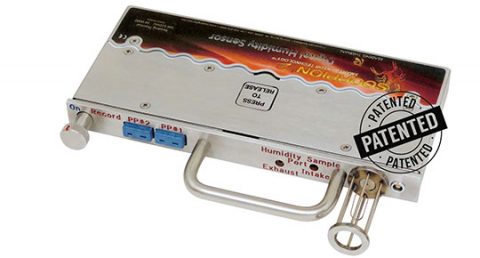Use our moisture logger to explore what is happening inside your industrial bakery ovens. Measuring humidity with the SCORPION® 2 Profiling System and Data Logger and the Digital Humidity Sensor from Reading Thermal can help you improve your products and processes.
The experts at Reading Thermal, a Reading Bakery Systems brand, have researched and investigated the commercial baking process for more than 25 years. Our team of heat transfer experts developed the SCORPION® 2 Profiling System, now an industry standard that measures and maps essential baking parameters, such as humidity, that affect the quality of your products.
Measuring Oven Humidity
The SCORPION® Digital Humidity Sensor provides a better way to measure humidity in your oven, proofer, dryer, and cooling tunnel. The sensor travels through the oven with the product, yielding a precise profile of moisture it experiences.
Mechanically, the Digital Humidity Sensor includes an Air Temperature sensor, two inputs for Product Core Temperature Measurement, and a proprietary humidity sampling system to measure Dew Point Temperature, Absolute Humidity, and Relative Humidity.
Its breakthrough design provides a more accurate and reliable way to measure the absolute moisture content of the thermal environment. The sensor contains a proprietary humidity sampling system with patent pending Anti-Saturation Technology™ that allows measurements in high temperature and very high dew point processes.
The Digital Humidity Sensor is engineered to be compatible with direct gas fired (DGF) ovens. Unlike oxygen sensor technology, which can be off by as much as 25% due to combustion gases in DGF ovens, the accuracy of the Digital Humidity Sensor remains the same regardless of the oven platform.
Other Measurements
Connecting smart sensors and sensor arrays to the SCORPION® 2 Profiling System and passing them through the oven with the product, enables the measurement system to capture:
Temperature (air, band and product core): Oven temperature impacts oven-spring, drying/dehydration, and color formation during baking. Insufficient or excessive heat can also lead to unwelcome changes in texture and taste. The Scorpion® 2 Temperature Sensor Array measures the temperature at product level, in fixed positions across the conveyor, and delivers a precise picture of temperatures from side-to-side and end-to-end.
Air flow (velocity): In a convection oven, the airflow comes primarily from the air distribution plenums. In a radiant oven, it comes from the moving conveyor, the exhaust system, and natural combustion air currents. Measuring oven air velocity with the SCORPION® 2 Air Velocity Sensor is crucial because airflow will influence the texture, firmness, coloration, and baking time of the final product. The profiles will help you spot airflow differences between baking zones and undesirable air currents at the entrance or exit of the oven that can cause inconsistent baking.
Heat flux (energy transfer): Certain product characteristics are defined by the amount and type of heat applied during the baking process. The differences explain why one oven bakes differently than another. And analyzing and controlling these differences is critical to understanding how the finished characteristics of your products will be affected. The SCORPION® 2 Heat Flux Sensor measures radiant and heat fluxes at product level and displays the results in Btu/hr·ft2 or convective W/m2.
Avoid poor quality baked goods (color, texture, flavor) by taking advantage of a state-of-the-art moisture logger from Reading Thermal. Made in the USA, our powerful diagnostic tool, the SCORPION® 2 Profiling System can help you improve your proofing, baking, cooling, and freezing processes. Contact us online or call us at (610) 678-5890 Ext. 2 to learn more.

